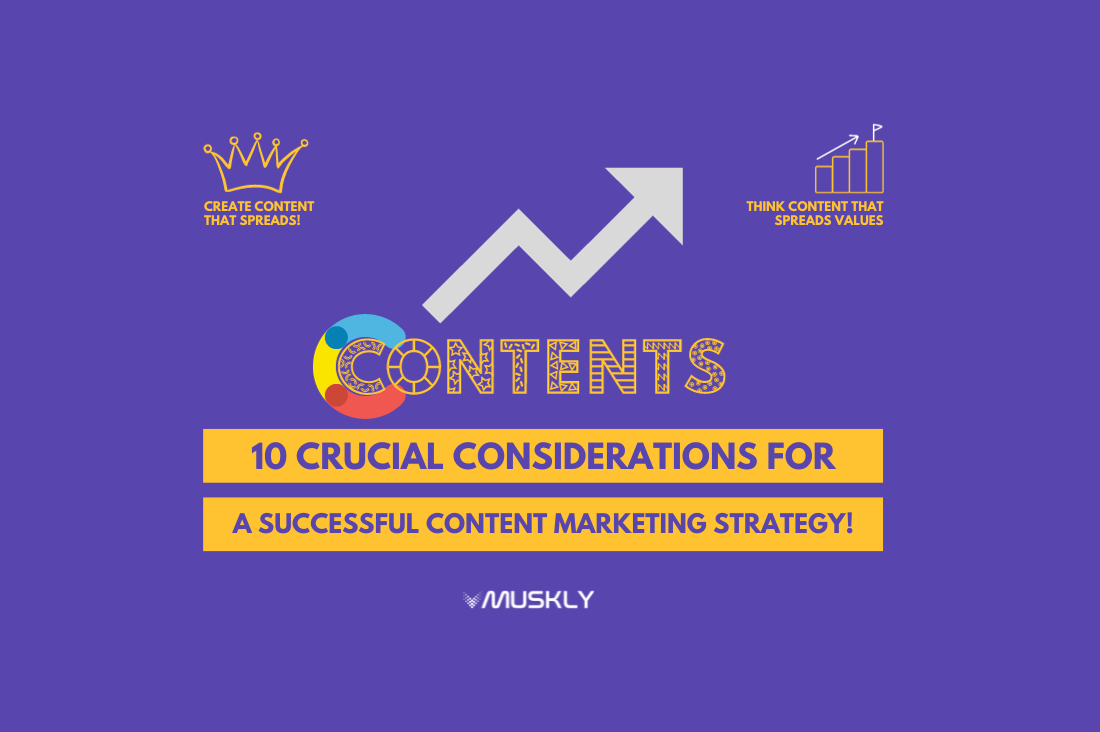10 Crucial Considerations for a Successful Content Marketing Strategy!

by MUSKLY
To help you build a successful content marketing strategy, we asked ten CEOs and content strategists for their crucial considerations. From developing and refining buyer personas to monitoring competitors and adjusting strategy, discover the top ten insights these leaders shared.
- Develop and Refine Buyer Personas
- Set Clear and Measurable Goals
- Understand Your Audience Through Research
- Define Your Content’s Unique Value
- Maintain Consistency in Content Marketing
- Analyze Online Data and Competition
- Create Relevant and Engaging Content
- Integrate Content Strategy With Marketing Efforts
- Establish Authority in Your Content
- Monitor Competitors and Adjust Strategy
Table of Contents
ToggleDevelop and Refine Buyer Personas
One crucial step in creating a successful content marketing strategy is developing and refining buyer personas. Buyer personas lie at the very core of any successful marketing strategy, influencing all touch points and stretching their impact.
Dropping the ball on crafting connections that truly click with potential customers breaks trust and interest. Buyer personas gift you a super-smooth marketing skill blanket, helping you bullseye the perfect crowd at just the right time, loaded with content that vibes perfectly with your audience.
Hannah Girmai, Content Strategist
Set Clear and Measurable Goals
Defining clear and measurable goals is a crucial consideration in creating a successful content-marketing strategy.
Establishing specific objectives, such as increasing brand awareness, driving website traffic, or generating leads, provides a strategic direction for your efforts. These goals serve as a roadmap for content creation, distribution, and performance measurement.
Aviad Faruz, CEO, Know Mastery
Understand Your Audience Through Research
One of the crucial considerations in creating a successful content marketing strategy is understanding your target audience. This means knowing their needs, wants, and pain points. Once you understand your target audience, you can create content that is relevant and valuable to them.
Here are some specific tips for understanding your target audience:
Conduct market research: This involves understanding the demand for your product or service, as well as the needs and wants of your target customers. You can conduct market research by talking to potential customers, surveying them, or analyzing data from social media or other sources.
Create buyer personas: Buyer personas are fictional representations of your ideal customers. They should be based on your market research and should include information about their demographics, their needs, and their pain points.
Brenton Thomas, CEO, Twibi
Define Your Content’s Unique Value
A pivotal element in a content marketing strategy is identifying your brand’s unique content value, setting it apart from competitors. Consider this: What distinct insights or solutions does your content offer?
Rooting your strategy in a clear content marketing mission statement is key. This statement should encapsulate whom you’re serving, the value you’re providing, and the results your audience can expect.
Matias Rodsevich, CEO, PRLab
Maintain Consistency in Content Marketing
Do what you can do consistently. Content marketing is such a broad scope, so you need to consider your resources and time. You don’t have to be everywhere to make content marketing work. Consistency is key because it helps you set your audience’s expectations. When you know what your audience needs and wants and how they prefer to engage, you’ll be doing better than the majority of content marketers out there.
Alli Hill, Founder and Director, Fleurish Freelance
Analyze Online Data and Competition
Understand your target audience!
To create content and plan a full-blown content marketing strategy, it’s crucial to understand your target audience.
What makes them need to find you, your product, or your service?
If you already have an online presence, the answer to these questions can be found in your online following. Start by auditing the followers you already have.
Then, review data like website and social media analytics to better understand the content your followers enjoy and how they are finding your page.
Last, identify your competition and see who else your followers are following. After doing this, you’ll have a better understanding of who you should target and what your positioning should be.
This is crucial because if you have the answers to these questions, you can produce relevant content that engages your audience and converts later on.
Chelsea Evans-Flower, Owner, Scott Social
Create Relevant and Engaging Content
Ensure that the content you produce is relevant and resonates with your target audience. The content you produce should be tailored to meet the needs and interests of your target audience. Content that is relevant and resonates with your target audience will be more likely to engage, share, and convert.
For example, let’s say you’re a tech company that sells software to businesses. Your target audience is likely to be business owners and IT professionals. When you create content, you need to make sure that it applies to their needs and interests.
You might create content about how to use your software, how to improve your business or the latest trends in technology.
Besides that, you also need to make sure that your content is well-written and engaging. If your content is boring or difficult to read, people are less likely to read it. You can make your content more engaging by using visuals, humor, and storytelling.
Luciano Colos, Founder and CEO, Pitch Deck Grader
Integrate Content Strategy With Marketing Efforts
When creating a content marketing strategy, one of the most important questions you can ask is, “How can I connect the dots?” By this, it means, how does this marketing strategy improve your other marketing strategies?
The strategies that communicate together are the ones that create compounding results for your company. If there is no way to connect a new campaign to your existing ones, it will most likely lead to mediocre results.
Jason Vaught, Director of Content, SmashBrand
Establish Authority in Your Content
It’s crucial to consider, “What are you trying to say, and who are you to say it?” when you’re creating a content strategy. This helps you prioritize the need for resources that solidify your expertise in the space. This could mean any of the following:
- You have first-party data to support this.
- You have public data resources that can support this.
- You have internal staff members with the authority and influence to talk about this.
- You have access to external influencers or subject experts who can help us.
Derek Flint, Marketing Manager, Ten Speed
Monitor Competitors and Adjust Strategy
Knowing your audience is key to crafting an effective content marketing strategy. At ZenMaid, we’ve found this to be the foundation of success.
You must understand what your audience cares about, what they find helpful, and how they prefer to consume information, not just create content. In our case, that meant a blend of blog articles, videos, and infographics.
But knowing your audience isn’t enough. You also have to monitor what’s happening around you, and that includes your competitors. What are they doing that’s working? Where are they finding success? Understanding these trends can guide your content in the right direction.
Start with a survey, engage your audience, and then tailor your strategy. It’s not a one-size-fits-all, and that’s what makes it effective. Find what fits your audience, and go with it.
Amar Ghose, CEO, ZenMaid
40
SHARES
MUSKLY
MUSKLY is an award-winning creative content marketing & SEO-centric TECH DigitalPR agency; helping software companies & SaaS brands generate more LEADS & SALES by CRISPY copywriting, premium link building, and content creation.
Recommended Posts

10 Most Effective Tips for Emailing Press Releases to Journalists!
February 10, 2024

8 Essential SEO Tips for New Bloggers to Boost Traffic!
January 5, 2024

